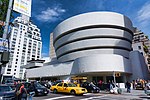Galerie Chalette

Galerie Chalette was a private contemporary art gallery in Manhattan, New York, USA. It was founded by the married art dealers and collectors Madeleine Chalette Lejwa (1915–1996) and Arthur Lejwa (1895–1972) in February 1954. The Lejwas were refugees from the Nazi incursions into Poland and France. Initially, their gallery specialized in contemporary French and Polish prints and painting. Later they changed its focus to contemporary 20th century American and European Sculpture, and especially the work of Jean Arp."La Chalette" was perhaps best known for organizing important group exhibitions which were then offered to various museums around the United States, including Construction and Geometry in Painting (1960), and Structured Sculpture (1960, 1968), as well as their major Arp exhibition, Jean Arp : from the collections of Mme. Marguerite Arp and Arthur and Madeleine Lejwa, at the Metropolitan Museum of Art, in 1972.The gallery closed in 1978.
Excerpt from the Wikipedia article Galerie Chalette (License: CC BY-SA 3.0, Authors, Images).Galerie Chalette
East 88th Street, New York Manhattan
Geographical coordinates (GPS) Address Nearby Places Show on map
Geographical coordinates (GPS)
| Latitude | Longitude |
|---|---|
| N 40.782691 ° | E -73.958544 ° |
Address
East 88th Street 9
10128 New York, Manhattan
New York, United States
Open on Google Maps






